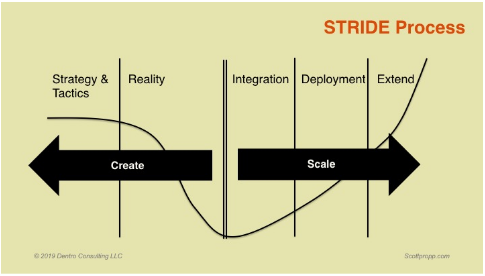I’ve had a series of calls with key leaders in the last few weeks as they prepare for 2021. The consensus is it’s setting up to be a hybrid year: we’ll still be in COVID limbo, with client firms that are full digital in remote work, manufacturers that have live operations and remote R&D, and finally, firms that are back in the office (acknowledging as of this writing that while we have a vaccination in the pipeline, COVID will continue to have a very real impact for the majority of your year).
What’s the impact? For the vast majority of the firms, this will feel like a year where you have highly distributed groups of resources. Distribution of resources acts as a tax on progress and demands strong intentional leadership to create momentum. Think of it like running a geographically distributed team, even if they are all local to your area. For those of you that have only lived in a collocated space, you need to be really intentional about context setting, establishing a clear line of sight to goals, and getting comfortable that your team members can find, form, and execute the detailed sub-projects.
A common theme of these calls has been a real concern that while some firms were able to pivot enough to have a solid year in 2020, the question remains: will they have the right people, processes, and technology in place if the second half of 2021 booms as is being forecast?
In short, there is a haunting concern that they might not be able to execute the strategic shift that they know needs to be completed for 2021. The concern they have is that while they have been able to execute on the trajectory that they entered 2020 with, everyone I spoke to sees the need to change lanes and accelerate in 2021. For them, these strategies are some combination of focus and complexity removal, adding new capability through acquisition, or doubling down on digitizing the core.
We know from research into past downturns that industries tend to perform as a group during the crisis. But afterword the pack separates – with the most adaptive firms seeing much higher returns on their investments.
From my discussions, I think concerned executives have a valid point.
The ‘Ghost Meetings’ That Used to Take Place
When you think back to pre-COVID (seems like years), you can recall that from a strategic point of view, many saw strategic work as three steps: discern the strategy, develop the tactics and measure the implementation. Many times there is a handoff between building the strategy and constructing the implementation plan.
The output of this? Many experienced what I call the “progress by meeting syndrome,” with the operational demands of the day-to-day business consuming the top talent with an urgent and unending yellow brick road of tasks. Then you see it on the calendar – the quarterly strategy check-in meeting. There are some panic meetings and you spend all weekend on a deck that puts the best face on your tactical actions to speak to strategic progress. Some version of this rinse and repeats in corporations globally.
What held this all together was the informal communications that we all had prior to the pandemic, which turned collocated teams into remote subject matter experts overnight. With the evaporation of the “backchannel,” strategic progress becomes one dimensional at best.
The good news is that we can borrow learnings from teams like large-scale geolocated teams for best practices to solve these issues.
The Key to Really Moving the Sticks
Why does this pattern persist? (Solid strategic intention, distracted implementation).
Many feel if we only up our program management chops, we can solve this – we just aren’t using all the tools in our toolbox. Others see it as a resource issue, and in that, there is a clue.
The true root is a bit deeper. The clue is in the tactics, which are usually directionally correct, but set up tension because they don’t appear to relate to “our day job.” The gap between these tactical actions and the measurable outcome in today’s reality outline the role of a strategic implementation effort.
Most strategic work ends once the high-level work is done. There is a good intention, but very low levels of buy-in, traceability and attachment to the process needed for the outcome. Once the strategic direction is set, the second phase of strategic implementation needs to happen.
Key events for this phase are:
- Pressure testing the strategy to break it into work streams that can be stack ranked by leverage.
- An analysis of how to apply the firm’s best strength to the highest leverage point for completion of that goal.
- A clear hypothesis of how achieving that specific breakthrough will improve the performance of the whole team
- A commitment to work the strategy in a focused and disciplined way, one breakthrough at a time, to build a cascade.
A Structured Approach Leads to Strong Implementation
A well-built strategy provides the opportunity for teams and subject matter experts to do what they do best in a framework that captures and multiplies their efforts. A strong strategic implementation framework does the same for those who need to execute the strategy.
Separating the creation from the execution portion of the strategy, while making room for real strategy and planning, is the hallmark of a good strategy process. I’ve built a framework that has proven useful across a variety of challenges with the acronym STRIDE.

This framework explicitly separates the work into five phases which each complete the needed decisions and planning – leading to results at scale. For more on STRIDE, see posts (here, here, and here).
For 2021, the key differentiator will be time to executed initiatives. Your strategic work has to be done well, and you need an explicit implementation plan that carries you from good intentions to results. Of course these skills lay the foundation for compound benefits, making you and your teams able to achieve higher levels of performance in ambiguous situations.
If you’d like to talk more about what it takes to have a successful journey through the early phases of installing your hard won strategic insights, we should talk. Please reach out by using this link. Or give me a call at (847) 651-1014.
Related posts you can benefit from…


